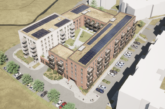
Jonathan Bainbridge from Bidwells looks at the planning issues facing the capital.
There hasn’t been a more interesting time to be working as a Planner in London. The planning issues facing the capital and Mayor of London Sadiq Khan, are wide-ranging and profound. From Brexit to the night-time economy, with the impact of the city’s high land values and the need for significantly greater levels of affordable housing, London is facing some of the biggest challenges of recent times. To battle with this the Mayor’s approach to development is going to have to be courageous, collaborative and innovative.
The many challenges have resulted in a draft London Plan which is highly prescriptive and a staggering 525 pages long. Within the draft are bold policies and initiatives, including the ‘Good Growth’ agenda and a renewed focus on densification which recognises the opportunity for colocation of commercial and residential uses.
Looking at the housing challenge in particular, the Mayor has identified that London requires an additional 66,000 homes each year in order to meet current demand. An increase of 53% compared to the current plan.
The proposed plan has indicated the majority of these additional homes will be provided in areas of high accessibility within outer London boroughs. 69% of the increased total requirement is to be provided within Labour-controlled councils and there is a clear trend to increase numbers particularly in outer London ‘suburbia’.
Affordable homes
Underpinning the approach to housing is a considerable need for 43,500 affordable homes. To meet this, the draft Plan builds upon the Mayor’s threshold approach to viability introduced in August 2017. This policy outlines a strategic target for achieving 50% of all new homes as affordable. Facilitating this is a requirement that residential development must provide at least 35% affordable housing (increased to 50% on publicly owned land), or otherwise face in-depth public scrutiny through viability reviews and claw back mechanisms. The 15% gap will be filled through new grants and public subsidies. This new approach will force landowners to consider affordable requirements when assessing land value. Maintaining the profitability of a development whilst ensuring all policy boxes are ticked for local councils throws up yet another challenge for City Hall.
Next month sees local elections in all London boroughs except for the City of London. It is commonly reported in the media that there is an expectation for Labour to gain control of a number of traditional Conservative safe seats. More interesting however is the change that’s being mooted for Labour’s existing councils.
the Mayor has identified that London requires an additional 66,000 homes each year in order to meet current demand
With the growing influence of the left wing pressure group Momentum, it is widely expected that we’ll see a further shift to the left in some Labour councils. Momentum, with their self-described ‘anti development’ positioning, is likely to make the delivery of viable residential planning permissions yet more challenging.
Green belt
A potential solution to the capital’s housing crisis is the managed and selective ‘swap’ of poorly performing Green Belt land. With a title that confuses the purpose of the Green Belt with that of green field, undeveloped, ecologically valuable land, it is perhaps easy to understand why it evokes such emotive protectionism.
This issue is not new. In 2015, the Adam Smith Institute released a paper* which suggested that releasing 3.7% of Green Belt land would enable the delivery of one million new homes in highly accessible locations.
Regardless, Khan is resolute that Green Belt should remain sacrosanct and is publicly noted as supporting the strengthening of Green Belt protection, regardless of the requirement to reflect national planning policy.
This issue is of huge significance to the success of the replacement Plan and the political relationship between London and the districts which make up its hinterland. If London boroughs cannot take brave steps to allow for controlled development in appropriate locations, greater pressure will be placed on their neighbours. Khan could be described as having his cake and eating it in this respect – and it is one particular area where we can expect extensive debate and discussion through the Plan’s future examination.
Whilst we’ve scratched the surface of the issues that are being played out in London here, it is widely expected that planning strategies for strategic development will become far more politically charged in the capital.
In the immediate future, pending applications may be held in abeyance until political uncertainties are resolved and, if as expected, Momentum take significant control, the approach that they take becomes clear.
In an effort to balance this, and to ensure that London delivers against its housing need, we can foresee the Mayor utilising his powers for call-in more widely, where the delivery of new homes is being curtailed.
Jonathan Bainbridge MRTPI is an Associate at Bidwells. www.bidwells.co.uk








